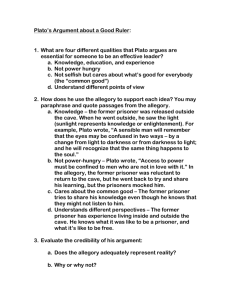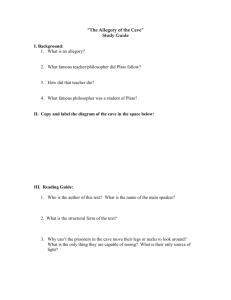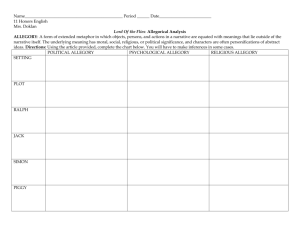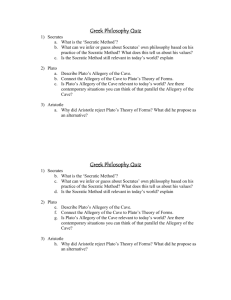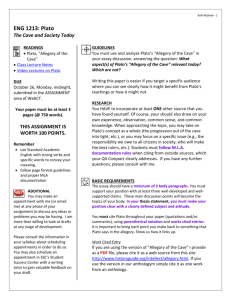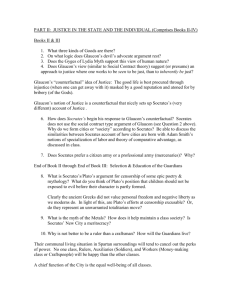Model Critical Lens Essay Deconstructed
advertisement
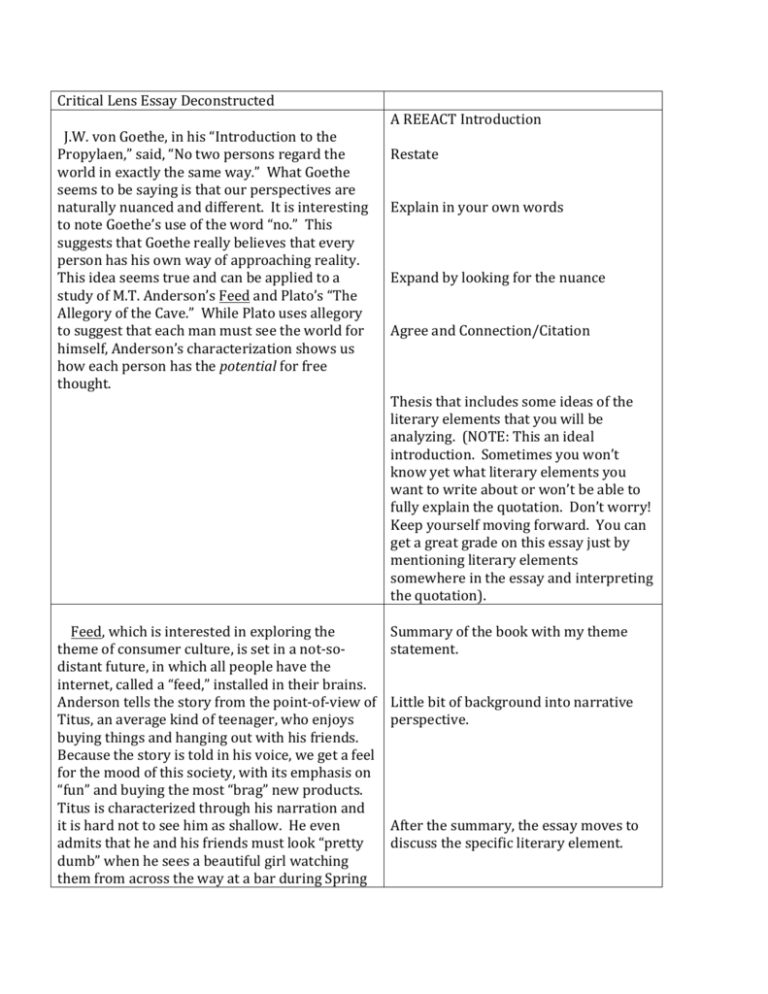
Critical Lens Essay Deconstructed J.W. von Goethe, in his “Introduction to the Propylaen,” said, “No two persons regard the world in exactly the same way.” What Goethe seems to be saying is that our perspectives are naturally nuanced and different. It is interesting to note Goethe’s use of the word “no.” This suggests that Goethe really believes that every person has his own way of approaching reality. This idea seems true and can be applied to a study of M.T. Anderson’s Feed and Plato’s “The Allegory of the Cave.” While Plato uses allegory to suggest that each man must see the world for himself, Anderson’s characterization shows us how each person has the potential for free thought. A REEACT Introduction Restate Explain in your own words Expand by looking for the nuance Agree and Connection/Citation Thesis that includes some ideas of the literary elements that you will be analyzing. (NOTE: This an ideal introduction. Sometimes you won’t know yet what literary elements you want to write about or won’t be able to fully explain the quotation. Don’t worry! Keep yourself moving forward. You can get a great grade on this essay just by mentioning literary elements somewhere in the essay and interpreting the quotation). Feed, which is interested in exploring the Summary of the book with my theme theme of consumer culture, is set in a not-­‐so-­‐ statement. distant future, in which all people have the internet, called a “feed,” installed in their brains. Anderson tells the story from the point-­‐of-­‐view of Little bit of background into narrative Titus, an average kind of teenager, who enjoys perspective. buying things and hanging out with his friends. Because the story is told in his voice, we get a feel for the mood of this society, with its emphasis on “fun” and buying the most “brag” new products. Titus is characterized through his narration and it is hard not to see him as shallow. He even After the summary, the essay moves to admits that he and his friends must look “pretty discuss the specific literary element. dumb” when he sees a beautiful girl watching them from across the way at a bar during Spring Break. His resulting narration tells us even more about his intelligence: “She was, like, the most beautiful girl, like, ever.” The use of the colloquial “like,” clearly a satire on the teenage speak of today, shows us that Titus has great difficulty expressing complex thoughts. One of the most outrageous examples of how uninformed Titus is occurs when he explains the history of the feed and tells the reader that the feed is great because it lets you look up stuff like “what battles in the Civil War George Washington fought in.” Although the early narration characterizes Titus as a kind of consumerist drone, Anderson is quick to introduce a series of details that show that Titus does see the world in a slightly different way than his friends. After he and his friends are hacked, Titus begins a relationship with the strange girl from the bar, Violet, who teaches him to appreciate things beyond the feed. Violet grew up poor, without a feed, and has an appreciation for a wide range of things, including writing , which almost everyone has lost the ability to do. Violet seems less controlled by the technology around her and slowly Titus begins to see the value in not being plugged in all the time. We can see the change in Titus, in part, by the way his language changes. He starts to use more metaphors and similes to describe what is around him. The word “like” is no longer just an interrupter. More importantly, he starts to notice all the ways in which his friends seem to have become slaves to consumer whims. When one of his friends, Calista, gets a fake lesion (cut) in her arm because all the celebrities are doing the same thing, he texts Violet about how disgusted it makes him. This transformation suggests that even in a highly commercialized society, individuals, like Titus, can find their own way of seeing the world. Plato makes a similar point in his “Allegory of the Cave,” which is taken from The Republic. and explores the duties the enlightened man has to rule. The “Allegory” is actually a dialogue between the wise Socrates and his student Glaucon. In the dialogue, Socrates is trying to First, example of the literary element. Second specific example of a literary element. Third example of the literary element Comes back to the critical lens quotation Little bit of plot synopsis to set up how the character is developed Example number one Example number two Example number three Theme statement Summary of the text convince Glaucon that the majority of mankind is enslaved in an allegorical “cave.” As he describes it, each man cannot look to his left or right and only sees the wall in front of him, on which shadows are projected. These men assume that the shadows are reality. Plato is using the wall and shadows to symbolize archaic, unfounded beliefs and superstitions about the world. Socrates goes on to explain that if a man is released from the cave he will first be discombobulated but once he goes up out of the cave, he will begin to learn for himself about reality. The world above is a symbol for truth and the “Real” and Plato is clear that once a man is up in that world he sees things for himself. The actual form of the “Allegory” matches its ideas about human beings. The dialogue is a form of intellectual discovery that invites people with different viewpoints to argue through their ideas. Socrates is clearly a dialogue master and in some ways anticipates that Glaucon might resist his ultimate argument, which is that once humans have become enlightened, they have a responsibility to go back down into the cave and lead responsibly. By beginning his allegory with a scenario Glaucon can relate to (afterall, Glaucon had left Athens to join Socrates up in the hills surrounding the city, Socrates makes it easier for Glaucon to actually complete the rational argument for himself. While both “The Allegory” and Feed celebrate human being’s ability to think for themselves and to see the world in their own way, it should be noted that Feed ends on a much more negative note. After his initial awakening, Titus eventually slides back into the consumer mindset, dumping Violet, even as she is on death’s door and ironically, dating someone who has fake lesions all over her body. Anderson’s cautionary tale seems to be suggesting that humans can be free but too often chose enslavement instead. Plato, on the other hand, through the voice of Socrates, argues that change will be difficult but that with an acknowledgment of human’s ability to think for themselves, the whole world can change. First example of symbolism/allegory Second example of symbolism/allegory Discussion of somethingnew Project/theme of the work Conclusion paragraph begins with a comparison of something different.


